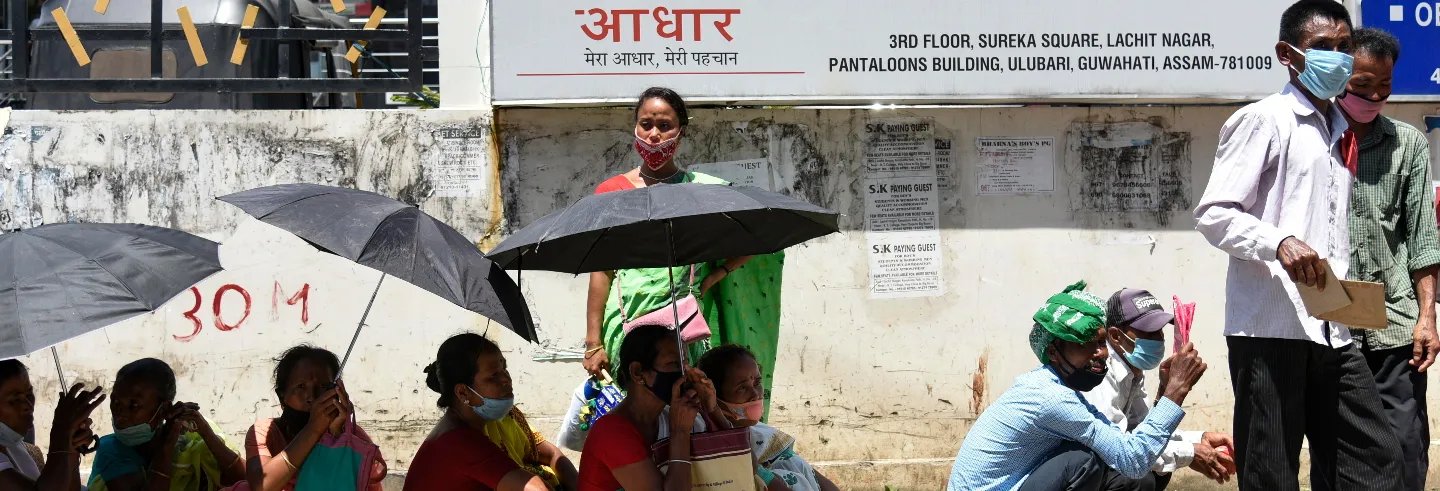Digital Public Goods (DPGs) are understood as digital artifacts such as software, platforms, datasets, or machine learning models which are made available in a universally accessible manner and meant for public welfare. As with any other public good, the “public” in DPGs refers to the citizens of the country, implying that the goods should be accessible to everybody and should have secured a basic democratic consensus about their purpose. Yet, many DPGs such as Aadhaar and the India Stack are rife with problems of accessibility and purpose definitions and exclude many publics.
Aadhaar-based biometric authentication failures, network connectivity issues, incorrect spellings of names, and hard to diagnose grievances continue to cause unfair exclusion from social welfare benefits for specifically marginalised publics. The stated purpose of Aadhaar to reduce inclusion errors at the cost of causing exclusion errors is also debatable – the interest of which publics is this serving? Similarly, the purpose of the India Stack to build eKYC procedures and improve financial inclusion for the poor has helped expand the market for money capital to provide formalised financial services which has made credit possibly safer in some ways than alternative informal services. But this has also increased the vulnerability of marginalised publics to faceless bureaucratic corporations looking for quick profits without investing sufficiently in consumer protection and financial literacy. Was solving for financial inclusion the most important priority for the poor?
The use of digital technologies should be understandable and manageable by local communities even if the technologies were not produced by them.
Most DPG infrastructures in India projected as a huge success have neither solved the problems of undemocratic and opaque governance processes, nor prevented the oppression and exploitation of marginalised groups by the elite. Rather, they have added new layers of technological complexity that the public now needs to navigate, without necessarily having made it easier for public demands to be met.
The gains and losses from such DPGs have not been equitably distributed. It is also not clear if they have met the priorities of the publics they claim to serve. Such technological solutionism not only disempowers many publics, but also distracts from strengthening more fundamental democratic devices to support the public in demanding accountability and transparency in governance and consumer service. It hinders from building community-based institutions that can represent the demands of diverse publics in a pluralistic democracy.
A different approach is possible to clearly define the public in DPGs and to ensure that DPGs meet the priorities of these publics.
Appropriate technologies and tools of conviviality
In Technology and (Dis)Empowerment: A Call to Technologists, I discuss how disempowering effects witnessed in DPGs often occur because technologists who design or manage them shut themselves off from acknowledging and reacting to the problems being faced by many publics, and because local communities are not provided with tools to participate in solving these problems either. Technologies imposed in a top-down manner or built specifically to disallow any local management further weakens community institutions. Consequently, new and unequal power relationships emerged between different stakeholders.
As a possible pathway for more responsible design and management, we need to instead build technologies that are conceptualised in democratic ways and managed by community-based institutions to impose social control over technologies, empower citizens, and bring equality. Such an approach can ensure that the technologies are appropriate to the context, can be managed and steered ethically through consensus and debate, their goals are clear, and the technologies are seen as enablers rather than as solutions in themselves.
The notions of appropriate technology as introduced by E.F. Schumacher and tools of conviviality as discussed by Ivan Illich can help articulate this approach.
Schumacher conceptualised appropriate technology as built using local materials, repaired and maintained by the local community, and meant to support their development. I interpret his work to argue that the use of digital technologies should be understandable and manageable by local communities even if the technologies were not produced by them. Different publics should be able to put these technologies for uses relevant to them, steer them towards responsible outcomes, and build strong community institutions for technology governance.
Technologies imposed in a top-down manner or built specifically to disallow any local management further weakens community institutions.
Illich similarly conceptualised convivial tools as those that can be managed in a convivial manner, and through this process also build conviviality in society. My interpretation, in today's context, is that technologies should be meant for collective use rather than individual use and with values of plurality embedded in them or imposed through their management.
These concepts can help change the current perspective of thinking about DPGs in a top-down manner which tends to reflect the priorities of the state or corporations, to rather conceptualise DPGs as infrastructures built for communities and managed through their participation.
Our work with Gram Vaani is an example of how a federated approach towards participatory media, which is moderated to ensure plurality and diversity, brings an element of conviviality by enabling diverse publics even in local communities to understand one another. Many operations of these participatory media forums are managed by local volunteers from the communities, which has helped build strong local institutional capacity for information management. This capacity has extended to other spheres, such as to guard against misinformation and political appropriation. This is starkly different from many other platforms that focus on individual personalisation of content or DPGs designed for self-service and individual access where no spaces are created for users to discuss problems and solutions and deliberate with one another.
Building technologies for communities
Following the principles of appropriate technology and conviviality, an alternative way to think about DPGs is to conceptualise them as technologies for communities. This will help acknowledge the diverse publics in DPGs, understand their values, priorities, and capabilities, and nurture structures of mutual support and conviviality. This will bring in democratic consensus to identify relevant DPGs and ensure that they are used towards goals defined by the communities.
Central to this framework are the ethics that underpin the design and management of technologies. Ethics provide a common language with which to describe the values that appear salient in the design of a technology – whether it is inclusive and appropriate to the context, whether it provides structures for accountability and control by its users, whom it empowers, whether it is equitable, and so on.
Who should identify such values, and how, to guide the design and management of technologies? The answer clearly lies in leveraging the structures of bottom-up democracy, rather than a small group of elite technologists or the state imposing their worldview in a top-down manner. Networks of public spheres are relevant here. They provide a learning function for society to appreciate the different concerns of diverse publics. They help democratically arrive at a consensus or an endless series of iterations to serve the interests of especially marginalised publics in priority. Finally, they are a means for technologists to discover the contexts in which technologies are used.
An alternative way to think about DPGs is to conceptualise them as technologies for communities.
Such a mesh of public spheres to define and translate into practice the underlying ethics of a technology can thus serve to put the control of technologies in the hands of communities and enable conviviality in society and also between communities and technologists.
As they stand, DPGs may actually not be benefiting the public they claim to service.
For example, the role of Aadhaar-based authentication to reduce inclusion errors at the cost of causing exclusion errors is clearly a priority imposed to reduce leakages under the assumption that leakages happen due to identity fraud. The focus to reduce leakages in fact strengthens the neoliberal narrative to cut down on welfare expenditure rather than to universalise welfare services.
An alternate way of thinking, as outlined above, may very well reveal that a more relevant DPG would have been for people to track their entitlements, provide feedback on the operation of welfare services, and get a guaranteed turnaround time on their grievances to reduce exclusions. Aadhaar infrastructure could have been used not just to prevent identity fraud but to use the digital trails created by it to monitor exclusions and address them proactively.
Similarly, instead of placing a nationwide priority on financial inclusion to facilitate lending, more urgent requirements may have emerged from the communities such as to tackle agricultural distress and climate change through more scientific and equitable planning of natural resource management, responsive extension and advisory services, and prompt and fair assessments and payments of crop insurance.
Essential elements in these DPGs for community participation in their governance would further help reflect the values and preferences of the diverse publics that the DPGs aim to serve. Further, to build a conducive policy environment in which appropriate and convivial DPGs are prioritised, meta-level DPGs will be needed, for example, to monitor whether policy debates revolve around structural issues rather than piecemeal relief, expose media biases that shape public opinion for policy making, find evidence of corporate influence on policy making, and provide access to open government data for citizens to audit and track resource allocation.
It is a mistaken belief that technology imposed top-down can solve corrupt or exploitative practices on the ground. Such practices can only be solved bottom-up by strengthening community institutions and providing them with the necessary tools that are designed with their participation and managed by them. DPGs built with such a vision as technologies for communities are likely to be more relevant and lead to more equitable empowerment in communities.
Aaditeshwar Seth is an associate professor in the Department of Computer Science and Engineering at Indian Institute of Technology Delhi, and co-founder of the social technology enterprise Gram Vaani.









